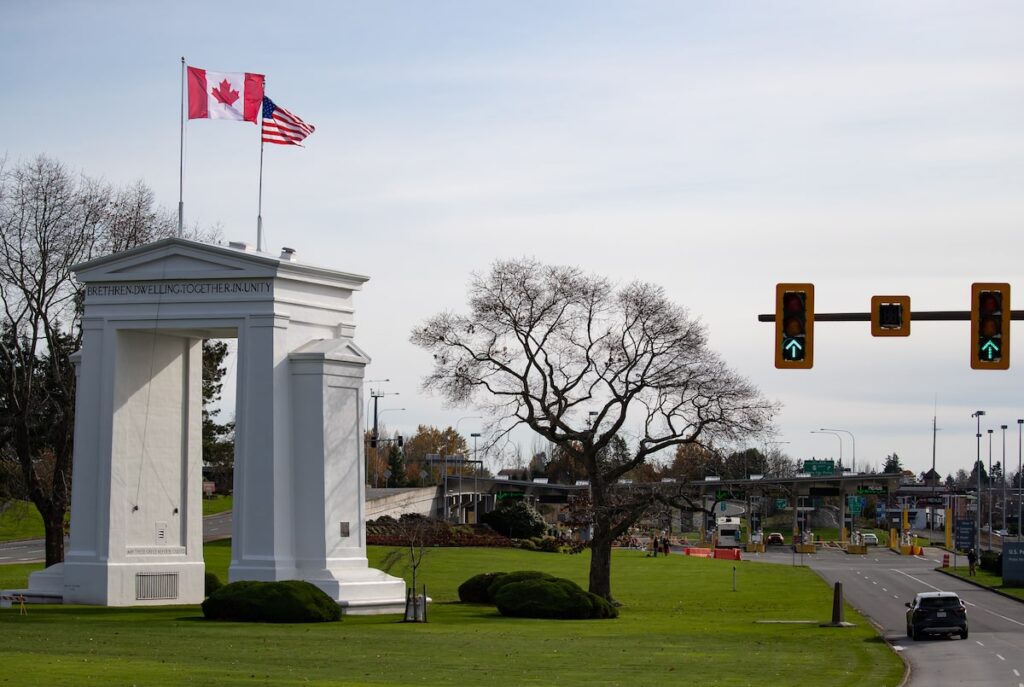Edward Alden and Laurie Troutman are the authors of the upcoming book When the World Shut Its Doors: The Tragedy of COVID-19 and the Future of Borders.
For more than a century, Canada and the United States have been justifiably proud to share the world's longest undefended border, stretching some 9,000 kilometres from ocean to ocean, maintained by a deep bond of trust between our two nations. The white marble Peace Arch, erected in 1921 astride the British Columbia-Washington state line, has become an international symbol of that cooperation and trust.
Until last month.
Canada and the United States have long allowed residents of both countries to meet freely, without passports, at the International Peace Park that straddles their border. But in late May, alarmed by an increase in “encounters” with people trying to cross the border illegally from Canada, the U.S. Border Patrol cut off direct access to the park. Although a common meeting spot remains near the arch, Canadians living along “0 Avenue” in Surrey, British Columbia, who have long been free to let their children play in the park across the ditch from the U.S. side, will no longer enjoy that privilege. U.S. agents now patrol the park, searching for illegal border crossers.
The move might be seen as just a small step to discourage the growing number of immigrants — many seeking asylum, others seeking economic opportunity — seeking passage into the U.S., Canada, Europe and other developed countries. That would be a mistake. Rather, blocking access to Peace Arch Park is a strong, symbolic step toward establishing a hard border between the U.S. and Canada, which the governments of both countries increasingly support.
Peace Arch Park is a unique place not only along the border but in the world. In 1952, singer and civil rights activist Paul Robeson performed in front of 30,000 people in the park when U.S. authorities confiscated his passport to prevent him from leaving the country. During the COVID-19 pandemic, it was the only place where people could meet, separated by the border closure between the U.S. and Canada. During the 19-month closure, thousands of people from both countries flocked to the park, where friends and families from across the border picnicked and couples pitched tents. The summer of 2020 became known as the “Summer of Love.”
Nowhere in the world have border restrictions imposed by the pandemic been so violated: Canadian health officials, concerned about the risk of cross-border infection, closed access to the British Columbia side of the park, but were unable to stop Canadians from crossing into the US.
Still, COVID-19 has sparked a change in Canadians’ attitudes toward the border that is likely to continue. For decades, Canadian officials have opposed “hardening” the border with the United States, especially because they feared it would stifle exports, the lifeblood of the Canadian economy. But COVID-19 has shown that it is possible to prevent movement of all but “essential” border crossers while still allowing trade to flow freely. And border closures have remained politically popular throughout the pandemic.
Now, pressure is building on the U.S. side to crack down on illegal immigrants from Canada. Republicans in Washington, led by Elise Stefanik, a New York Republican who is seen as a potential running mate for Donald Trump, are accusing the Joe Biden administration of “plunging the northern border into chaos.” Stefanik and others formed the Northern Border Patrol Caucus last year to push for tougher security measures. U.S. border security attention, which has been focused primarily on the southern border with Mexico, is steadily shifting north.
There is growing demand among Republicans to build a fence or other barrier on the northern U.S. border. Few remember that the U.S. and Mexico once had a border park. In 1971, First Lady Pat Nixon opened Friendship Park where the U.S.-Mexico border meets in the Pacific Ocean. People from both countries were free to gather, picnic, swim, and visit the border memorial. Over the decades, access was increasingly restricted and, during the pandemic, banned entirely. Today, the memorial stands on the Mexican side of a massive border fence that stretches all the way to the ocean.
Ironically, Canada has already built its first border fence along the 49th parallel. At Peace Arch Park, once the border reopened after the pandemic subsided, officials built a low wooden fence on the Canadian side and posted signs prohibiting entry from the US side. Canada doesn't actively stop Americans from entering the park, because the fence has gaps and can be easily jumped over. But Canada could easily close its side of the park at any time, for any reason.
Once the “cross-border threat” story is ingrained in the national conversation, it takes only a few steps to go from agents guarding the border to agents sealing it off with a fence. Just a few years ago, even in the aftermath of the 9/11 terrorist attacks, U.S. and Canadian border officials would have worked together to find joint solutions to the problem of illegal crossings through parks and other locations along our border. But sadly, the spirit of trust that has maintained an unguarded border for more than a century is beginning to crumble. If not shored up soon, it may be beyond repair.



